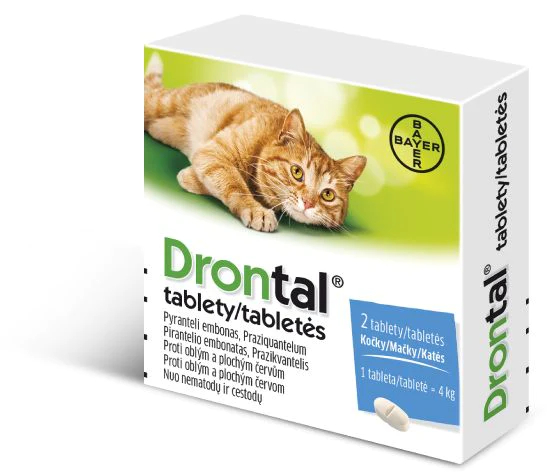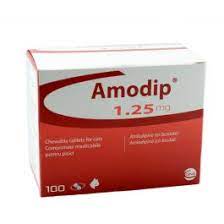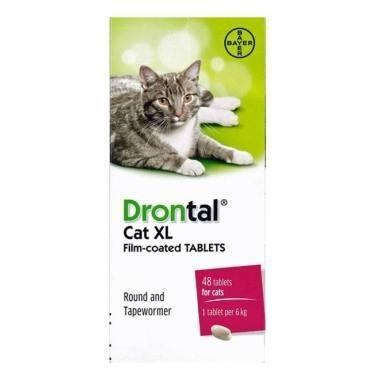Drontal Cat Film-coated Tablets Drontal Cat XL Film-coated Tablets Species: Cats Therapeutic indication: Pharmaceuticals: Endoparasiticides: Anthelmintics for cats, Tapeworm products Active ingredient: Praziquantel, Pyrantel Embonate Product:Drontal® Cat Film-coated Tablets Drontal® Cat XL Film-coated Tablets Product index: Drontal Cat Tablets Incorporating:Drontal Cat Film-coated Tablets Drontal Cat XL Film-coated Tablets Presentation Drontal Cat Film-coated Tablets are white to yellowish, scored, coated tablets that can be divided into equal halves. Each tablet contains 230 mg pyrantel embonate and 20 mg praziquantel with 1.8 mg Titanium Dioxide (E171). Drontal Cat XL Film-coated Tablets are unscored coated white to yellowish, ellipsoid, biconvex tablets, each containing 345 mg pyrantel embonate and 30 mg praziquantel with 2.6 mg Titanium Dioxide (E171). Uses For the treatment of gastrointestinal roundworms and tapeworms of cats: Toxocara cati, Toxascaris leonina, Dipylidium caninum, Taenia taeniaeformis (see ‘Further information’). Dosage and administration Dosage: The recommended dose rates are 57.5 mg/kg pyrantel embonate and 5 mg/kg praziquantel. This is equivalent to one Drontal Cat Film-coated Tablet per 4 kg body weight and 1 Drontal Cat XL Film-coated Tablet per 6 kg body weight. See dosage chart below for examples: Weight of Cat No of Drontal Cat Film-coated Tablets No of Drontal Cat XL Film-coated Tablets 2 kg ½ 4 kg 1 6 kg 1½ or 1 8 kg 2 10 kg 1 plus 1 Administration and Duration of Treatment For single oral administration. The tablets should be given directly to the animal, but if necessary can be disguised in food. Use During Pregnancy and Lactation Not to be used during pregnancy but may be used during lactation. Contra-indications, warnings, etc Not intended for use in kittens less than 6 weeks of age. Do not use simultaneously with piperazine compounds. Until sufficient studies have been performed with this combination, do not use during pregnancy. Fleas serve as intermediate hosts for one common type of tapeworm - Dipylidium caninum. Tapeworm infestation is certain to re-occur unless control of intermediate hosts such as fleas, mice etc. is undertaken. Mild and transient digestive tract disorders such as hypersalivation and/or vomiting and mild and transient neurological disorders such as ataxia may occur in extremely rare cases. User Safety In the interests of good hygiene, persons administering the tablets directly to a cat, or by adding them to the cat’s food, should wash their hands afterwards. For animal treatment only. Keep out of the reach of children. Environmental Safety Any unused veterinary medicinal product or waste materials derived from such veterinary medicinal products should be disposed of in accordance with local requirements. Pharmaceutical precautions Do not store above 25°C. Do not remove tablets from strip packing until required for use. Any part-used tablets should be discarded. Drontal Cat Film-coated Tablets: Shelf-life of the veterinary medicinal product as packaged for sale: 5 years. Drontal Cat XL Film-coated Tablets: Shelf-life of the veterinary medicinal product as packaged for sale: 4 years. Legal category Legal category: NFA-VPS Packaging quantities Drontal® Cat Film-coated Tablets: Cardboard cartons with polyethylene-coated aluminium foil blisters containing 2, 24 or 96 tablets in strips of 2 or 8 tablets. Drontal® Cat XL Film-coated Tablets : Cardboard cartons with polyethylene-coated aluminium foil blisters containing 2, 8, or 48 tablets in strips of 2 or 8 tablets. Marketing Authorisation Holder (if different from distributor) Marketing Authorisation Holder Vetoquinol UK Ltd. Steadings Barn, Pury Hill Business Park. Towcester. NN12 7LS Further information An anthelmintic active against gastrointestinal roundworms and tapeworms. ATC VetCode: QP52 AA51. Pharmacotherapeutic Group: Anthelmintics, Praziquantel combinations. The product contains two active ingredients, pyrantel embonate (pamoate) a tetrahydropyrimidine derivative and praziquantel a partially hydrogenated pyrazino-isoquinoline derivative, used widely as an anthelmintic for both human and veterinary use. Pyrantel acts as a cholinergic agonist. Its mode of action is to stimulate nicotinic cholinergic receptors of the parasite, induce spastic paralysis and thereby allow expulsion from the gastrointestinal (GI) system by peristalsis. Praziquantel is very rapidly absorbed and distributed throughout the parasite. Both in vivo and in vitro studies have shown that praziquantel causes severe damage to the parasite integument, resulting in contraction and paralysis. There is an almost instantaneous tetanic contraction of the parasite musculature and a rapid vacuolisation of the syncytial tegument. This rapid contraction has been explained by changes in divalent cation fluxes, especially calcium. In this fixed combination product, the pyrantel is active against the following ascarids: Toxocara cati, and Toxascaris leonina; the praziquantel is effective against tapeworms, in particular Dipylidium caninum and Taenia taeniaeformis. The product has been shown to be efficacious in the control of hookworms Ancylostoma tubaeforme and A. braziliense and the tapeworm Joyeuxiella pasqualei, none of which occur naturally in cats in the UK but may occasionally be found in imported animals. Praziquantel is effective against Echinococcus multilocularis. E. multilocularis does not occur in the UK but is becoming more common in some European countries. As a precautionary measure to prevent establishment of E. multilocularis in the UK, it is recommended that all dogs and cats entering the country be treated with praziquantel.




